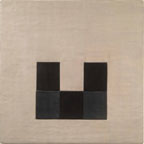Sequence
“Sequence: Barbara Kerwin in Santa Monica”
Kerry Kugelman, 2003
In her most recent solo exhibition at Ruth Bachofner Gallery, Barbara Kerwin eschews her usual proclivity for color and visual activity, grounding this body of work in an assured and graceful gravitas. Although Kerwin locates the conceptual matrix of her work in the realm of systems and order, its execution is refreshingly tactile and has, at times, had a sort of giddily careening quality in its informality. This most recent body of work is notable, however, for the comparative sobriety and restraint of both materials and content.
Kerwin's formal basis for some time has been her work with [oil in high melt wax], a medium of wax and damar resin, which must be heated to be colored or manipulated, cooling into solidity with a flesh-like surface texture. The [oil in high melt wax], thus colored, is layered onto a rigid support of paper or canvas over wood. Fascinated by the relationship of perceived beauty to ordered numeric and other systems (the Fibonacci series, for example), Kerwin has long worked with a grid-based organizational scheme, finding playful variations of color and form within the parameters she has set for herself.
But the undulating patterns of different-sized and colored squares that had been a hallmark of her previous work have been replaced by larger, separate pieces of [oil in high melt wax]-covered support, inserted into cut-out apertures in the larger panels. Where before an all-over chromatic approach was taken, now the colors that appear are used sparingly, and thus to greater effect where they do show up.
More telling is the move from the all-over grid of squares to the restrained sets of squares and rectangles in each work. The exhibition, a total of eight pieces, starts with only one inserted piece, then progressively builds both the number of actual inserts, and the implied relationships that begin to be suggested within each work. Three (all works 2003, [oil in high melt wax] on paper over wood), for example, lays out a tautology of balance between two white shapes, seemingly competing for or otherwise sharing a third, grey, shape, aligned with one side but not the other, the troika starkly laid out on a field of graphite-like grey.
As the number of shapes increases, though, the chromatic heat goes up, going to the flickering red-on-warm grey of Thirteen, the red parts of which seem about to swell out of their boundaries, yet held in check by their tight arrangement. The sequence culminates with Twenty-One, in which the red field engulfs the grey inserts, perhaps in a wave of passion. Now the all-over field of repeating shapes is almost back with us.
And make no mistake, this is passionate work. Kerwin escapes the rigidity that so often infects math-based or systems-derived work, because of her natural sense of sensuous tactility. The strangely flesh-like texture and color of the [oil in high melt wax], coupled with the relational dynamics of the inserted pieces, conveys a physicality that belies the highly ordered curiosity which drives Kerwin's explorations, and resonates with the mystery of living energy so tightly bound to the structures it inhabits.

